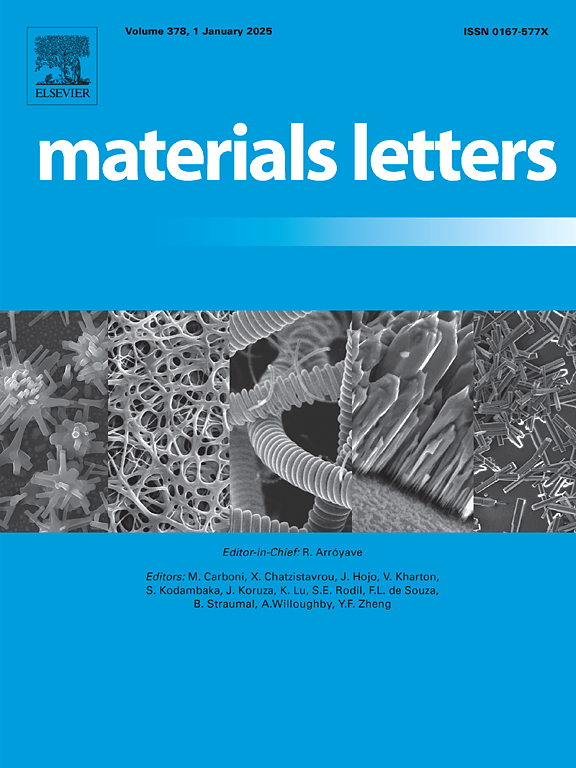油酸包覆氧化铁纳米颗粒用于增强磁动机超声和光声成像的油基幻影
IF 2.7
4区 材料科学
Q3 MATERIALS SCIENCE, MULTIDISCIPLINARY
引用次数: 0
摘要
幻影在临床超声成像质量控制中起着至关重要的作用。为了评估纳米颗粒作为造影剂的功效,研究人员经常使用由明胶、琼脂和各种聚合物等材料制成的幻影。然而,油酸包覆的氧化铁纳米颗粒(OA-IONPs)的疏水表面限制了它们在水环境中的分散,从而限制了它们在常规成像幻影和临床环境中的应用。在这项研究中,我们利用热分解方法合成了单分散的OA-IONPs (12-14 nm),对其进行了表征,并利用磁动机超声(MMUS)和光声(PA)成像评估了它们在油基幻影中的性能。结果表明,嵌入在油基幻影中的OA-IONPs可以作为有效的造影剂,在PA成像中产生约11.3 dB的信噪比(SNR),在纳米颗粒浓度为1.5 mg/mL的MMUS中产生4.8 μ m的位移。这些发现可能有助于增强合成策略的发展和生物医学成像技术的进步。本文章由计算机程序翻译,如有差异,请以英文原文为准。

Oleic acid-coated iron oxide nanoparticles for enhanced magnetomotive ultrasound and photoacoustic imaging in oil-based phantoms
Phantoms play a crucial role in quality control for clinical ultrasound imaging. To evaluate the efficacy of nanoparticles as contrast agents, researchers often use phantoms made from materials such as gelatin, agar, and various polymers. However, the hydrophobic surface of oleic acid–coated iron oxide nanoparticles (OA-IONPs) limit their dispersion in aqueous environments, thereby restricting their application in conventional imaging phantoms and clinical settings. In this study, we synthesized monodisperse OA-IONPs (12–14 nm) using the thermal decomposition method, characterized them, and evaluated their performance in an oil-based phantom using magnetomotive ultrasound (MMUS) and photoacoustic (PA) imaging. The results demonstrate that OA-IONPs embedded in oil-based phantoms can serve as effective contrast agents, yielding signal-to-noise ratio (SNR) of approximately 11.3 dB in PA imaging and a displacement of 4.8 µm in MMUS at a nanoparticle concentration of 1.5 mg/mL. These findings may contribute to the development of enhanced synthesis strategies and the advancement of biomedical imaging technologies.
求助全文
通过发布文献求助,成功后即可免费获取论文全文。
去求助
来源期刊

Materials Letters
工程技术-材料科学:综合
CiteScore
5.60
自引率
3.30%
发文量
1948
审稿时长
50 days
期刊介绍:
Materials Letters has an open access mirror journal Materials Letters: X, sharing the same aims and scope, editorial team, submission system and rigorous peer review.
Materials Letters is dedicated to publishing novel, cutting edge reports of broad interest to the materials community. The journal provides a forum for materials scientists and engineers, physicists, and chemists to rapidly communicate on the most important topics in the field of materials.
Contributions include, but are not limited to, a variety of topics such as:
• Materials - Metals and alloys, amorphous solids, ceramics, composites, polymers, semiconductors
• Applications - Structural, opto-electronic, magnetic, medical, MEMS, sensors, smart
• Characterization - Analytical, microscopy, scanning probes, nanoscopic, optical, electrical, magnetic, acoustic, spectroscopic, diffraction
• Novel Materials - Micro and nanostructures (nanowires, nanotubes, nanoparticles), nanocomposites, thin films, superlattices, quantum dots.
• Processing - Crystal growth, thin film processing, sol-gel processing, mechanical processing, assembly, nanocrystalline processing.
• Properties - Mechanical, magnetic, optical, electrical, ferroelectric, thermal, interfacial, transport, thermodynamic
• Synthesis - Quenching, solid state, solidification, solution synthesis, vapor deposition, high pressure, explosive
 求助内容:
求助内容: 应助结果提醒方式:
应助结果提醒方式:


